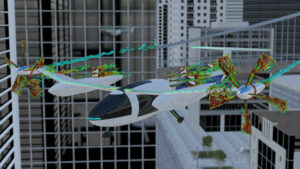A digital twin and a virtual twin are two terms used in the fields of industry, engineering and information technology to describe concepts that represent the virtual representation of physical objects or systems. As both terms are often used synonymously, it is rare to find a precise definition of them, but they can nevertheless clarify important aspects.
 The term “digital twin” was introduced by Grieves and Vickers. They emphasize that the concept of the digital twin is not only about the digital representation, but also about the communication between the real and the virtual object. By comparing and analyzing deviations between the two, adjustments can be made and processes regulated. At the center of this concept is the virtual object, which the real object must follow or adapt to. A key aspect is therefore bidirectional communication between the model and reality.
The term “digital twin” was introduced by Grieves and Vickers. They emphasize that the concept of the digital twin is not only about the digital representation, but also about the communication between the real and the virtual object. By comparing and analyzing deviations between the two, adjustments can be made and processes regulated. At the center of this concept is the virtual object, which the real object must follow or adapt to. A key aspect is therefore bidirectional communication between the model and reality.
 A virtual twin goes one step further and refers to the more comprehensive digital representation of a physical object or system in 3D, which enables, for example, precise localization of the data. An important direct application is virtual commissioning, which now offers manufacturers completely new possibilities thanks to the general further development of software and PLC (programmable logic controller) interfaces. This trend is complemented by physical simulation, which can be used at an early stage of development. All these developments require a consistently used 3D model.
A virtual twin goes one step further and refers to the more comprehensive digital representation of a physical object or system in 3D, which enables, for example, precise localization of the data. An important direct application is virtual commissioning, which now offers manufacturers completely new possibilities thanks to the general further development of software and PLC (programmable logic controller) interfaces. This trend is complemented by physical simulation, which can be used at an early stage of development. All these developments require a consistently used 3D model.
The main difference between a digital twin and a virtual twin lies in their scope and complexity. While a digital twin is a precise representation of a single object or system, a virtual twin can integrate multiple objects or systems and create a more comprehensive virtual environment. A virtual twin can therefore also be used to identify and evaluate the effects of individual changes on the overall system.
The revolutionary advances in information and sensor technology are leading to considerable potential for companies, which is crucial for future competitiveness. New computers are able to analyze large amounts of data. Even complex 3D models can be displayed in such a way that movements can be visualized smoothly. This creates a new quality in the analysis of processes that cannot be achieved without 3D visualization. A consistent 3D model also offers the possibility of achieving consistent modeling without interface losses and inconsistencies in the models. The increased clarity allows even non-experts to understand the models and can be used for training.

Virtual twins of cities can be used to analyze traffic flows, optimize urban infrastructure and plan urban development projects.

Digital twins of human organs or biological systems can be used in medicine to diagnose diseases, plan treatments and develop medical devices.

Virtual twins of energy supply networks or environmental systems can be used to improve energy efficiency, reduce environmental pollution and develop sustainable solutions.
In part, this text and illustrations shown are based on research of evaluated literature.
In part, however, the sources listed here should simply be understood as recommendations for further reading.
Complex Systems. Springer-Verlag, Berlin, Heidelberg 2017, p. 85 – 113
DOI: 10.1007/978-3-319-38756-7_4
